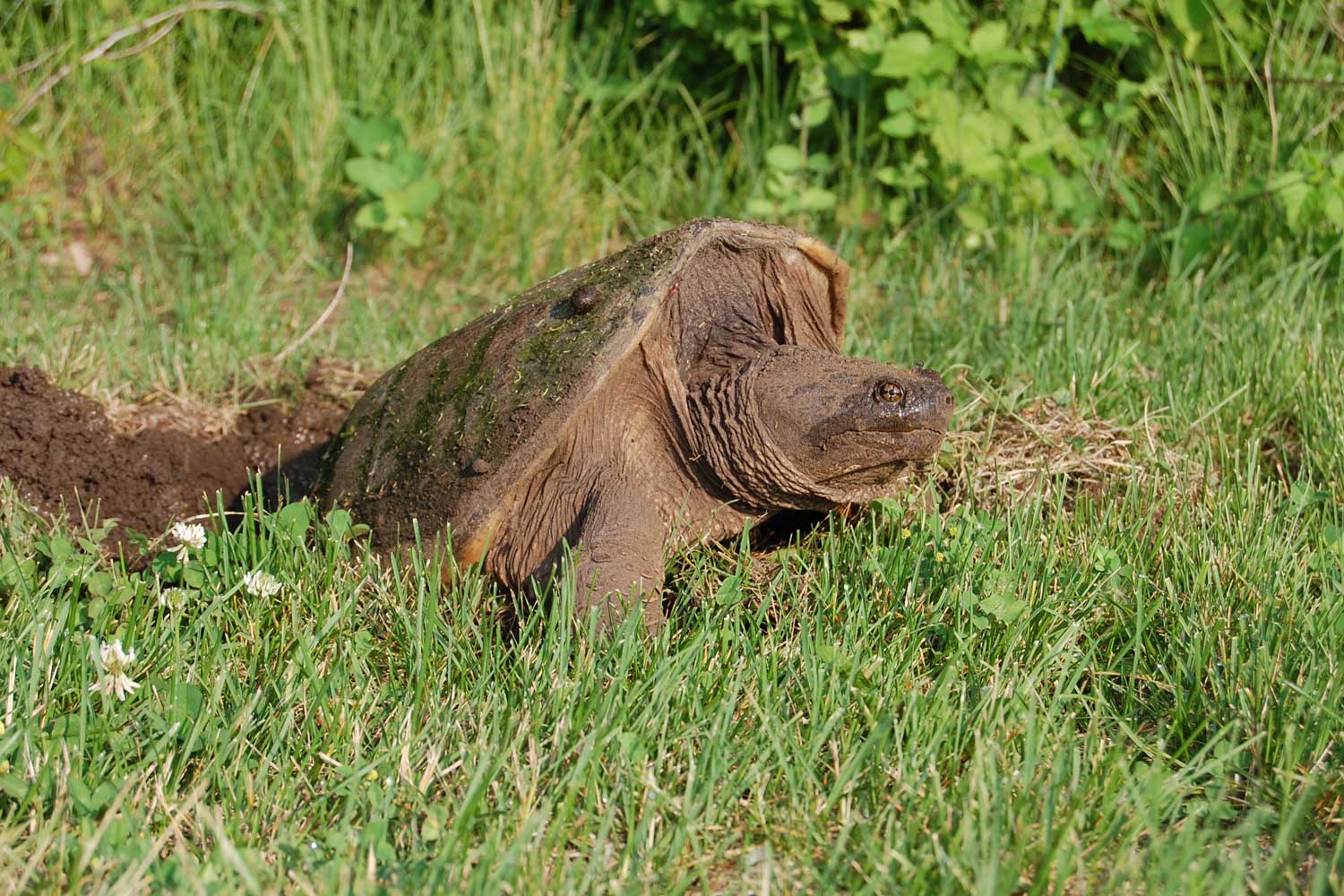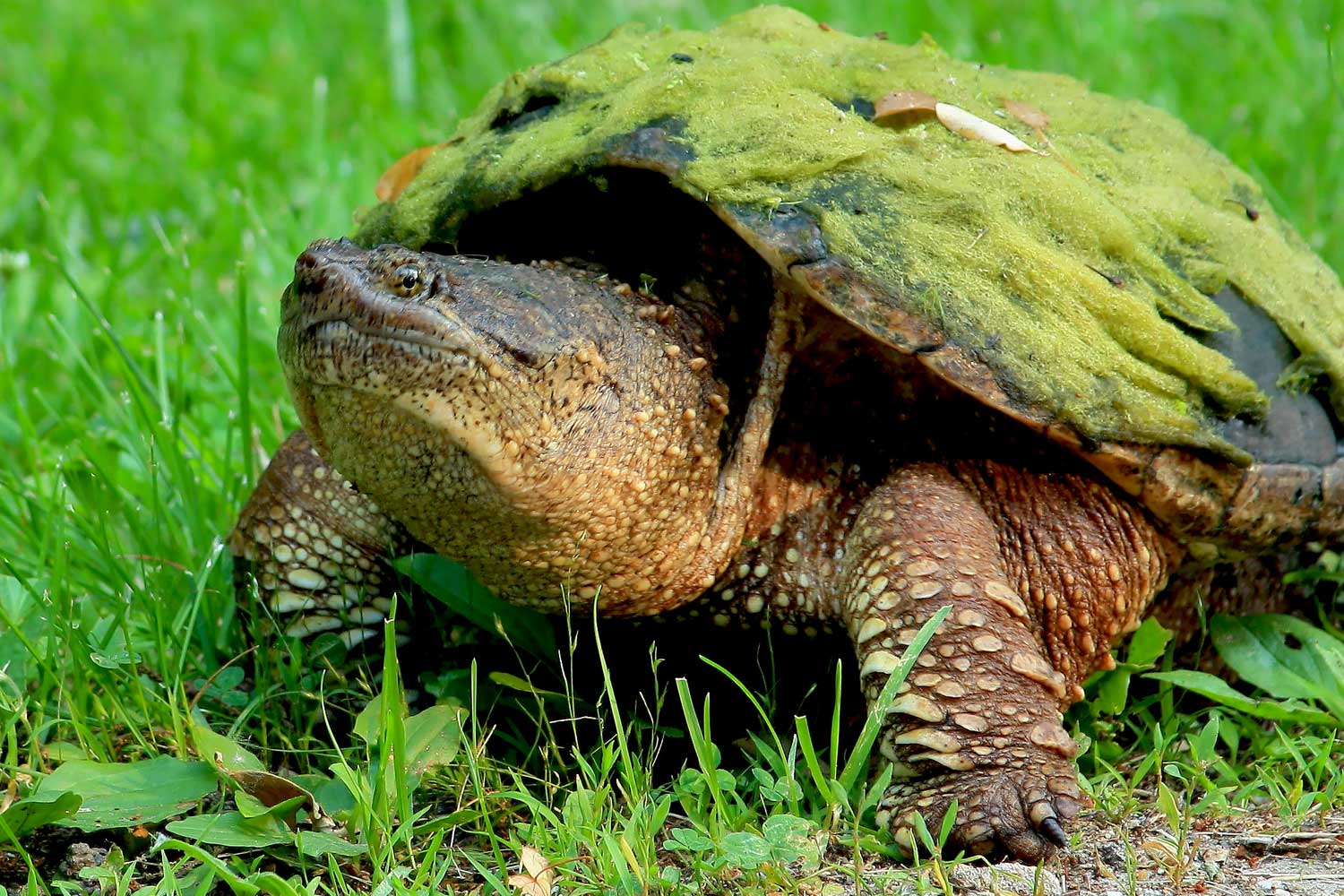Five fast facts about those not-so-ferocious snapping turtles

As turtles go, snapping turtles look a bit imposing. They're big, for starters, the biggest we see in northern Illinois by far. Plus they can appear to be a bit menacing, with their long claws and prominent noses. Their name certainly doesn't help either.
Snapping turtles will snap if provoked, but they aren't generally aggressive. In the water, they are usually calm and docile, and they aren't considered a danger to swimmers. However, they can be a bit more feisty on land, according to Animal Diversity Web.
The bottom shell of a snapping turtle, called a plastron, is quite small compared to its overall size, typically ranging from 8 inches to 18 inches long. The small size of their shells can leave them more vulnerable than some other turtles, particularly because it leaves them unable to retract their limbs and heads into their shells like other turtles can.
Their overall length can be twice as long as their shells thanks to their long tails, Animal Diversity Web reports. Their weight can vary considerably, from about 8 pounds to 35 pounds or more. Males are typically larger than females.
Read on to learn some fun facts about snappers.
There's more than one kind
When you think of snapping turtles, it's likely the common snapping turtle that comes to mind. However, there are actually two snapping turtle species in the world, and both live in Illinois. The second snapping turtle species, the alligator snapping turtle, is far less common than the common snapping turtle across its entire range, according to National Geographic.
In Illinois, alligator snapping turtles are endangered and seen infrequently, with less than 20 confirmed sightings in the state, according to the Illinois Natural History Survey. Their range does not include Will County or the northeast part of the state and, even where they have been recorded populations, they are scarce, most likely being lost-distant migrants from the large rivers that border Illinois.
So how can you tell the difference between a common snapping turtle and an alligator snapping turtle? Alligator snapping turtles look prehistoric, almost dinosaur-like, with primitive faces and large spikes on their shells. Common snapping turtles, on the other hand, have smooth shells. Alligator snapping turtles can also be quite a bit larger, with males weighing between 175 pounds and 220 pounds. Common snapping turtles, on the other hand, usually weigh no more than 35 pounds.
They lived with the dinosaurs
Snapping turtles have been around for so long they lived with the dinosaurs! That means they survived the mass extinction that wiped dinosaurs off the earth some 65 million years ago. Snapping turtles have existed for about 90 million years, and they evolved in North America, making them one of our oldest turtles, reports the National Audubon Society.
Today, snapping turtles live in eastern North America, as far south as Florida and as far north as Nova Scotia and Alberta, Canada. Ancestors of the snapping turtle in the Chelydrid family lived across Europe and Asia from about 40 million years ago until two million years ago when they went extinct. So our two snapping turtles in North America — the common snapping turtle and alligator snapping turtle — are the only snappers in the world.
Snapping turtles have changed surprisingly little in the 90 million years of their existence, the Audubon Society reports. They still look and live much the same as they did in the age of the dinosaurs.
Their bite is no joke, but it might not be as bad as you think
They don't call them snapping turtles for nothing, that's for sure. And it's not just a myth that they can bite a finger off. They can and have done it. The average common snapping turtle can bite with a force of about 210 Newtons; alligator snapping turtles aren't quite as powerful, with a bite force of 160 Newtons. That may seem pretty impressive, but a little context may prove otherwise.
Take, for example, lions. They can generate 4,450 Newtons of bite force. Even us humans can do much better than snapping turtles, generating 1,100 Newtons of bite force when biting with our second molars, Nature Discovery reports. Snapping turtles can inflict a lot of damage with their bites in part because their jaws are sharp and edged.
It's always a good idea to give snapping turtles — and all wildlife, for that matter — a wide berth, and this is especially true when they are on land. While these turtles aren't usually aggressive when in the water, they can be on land, according to the Illinois Natural History Survey. This could be because snapping turtles spend most of their time in the water, usually only coming on land during nesting season.
They live long lives by wildlife standards
Many of our most common critters have short lifespans because of the threats they face living in the wild, everything from collisions with vehicles to predation by other animals to disease. Most raccoons, for example, don't survive past their second year, and those that do live an average of five years, according to Animal Diversity Web. White-tailed deer can live 20 years at most, but few live more than 10. Most live only two to three years. Snapping turtles, though, have a long lifespan by animal standards, living up to 30 years in the wild. In captivity they can live almost 50 years.
Snapping turtles are most vulnerable before they hatch, when nests are predated by many other animals, and as new hatchlings, Animal Diversity Web reports. Once they are bigger, they have few predators, although they are at risk for getting struck by vehicles when crossing roads during breeding and nesting season.
It's not just snapping turtles that live long lives. Many turtles have long lifespans, and tortoises often live even longer. The oldest living land animal in the world is Jonathan the tortoise, who turned 190 in 2022, according to Smithsonian Magazine. Jonathan, a Seychelles giant tortoise, lives on the island of St. Helena in the South Atlantic Ocean. He's lived on St. Helena since 1882, but that's not the start of Jonathan's story. He arrived in St. Helena fully grown, meaning he was at least 50 years old at the time. Some believe Jonathan may actually be older than 190.
They are selective about their habitat
Snapping turtles are aquatic creatures, spending most of their time in water except for nesting, but not just any body of water will do. While you might find snapping turtles in all kinds of waterways — ponds, lakes, rivers, creeks, streams, marshes and more — they prefer shallow waters with muddy bottoms, according to the Illinois Natural History Survey. The muddy bottom is important because it helps the turtles hide from prey. They also seek out areas with plenty of vegetation for the same reason.
When looking for a meal, the turtles will sometimes bury themselves in muddy bottoms of the rivers, lakes and ponds where they live, leaving only their nostrils exposed. Then they lie in wait, and when something tasty passes by they snatch it, according to Animal Diversity Web. When it comes to food, they aren't picky. If they can grab it, they will eat it. They are omnivores, and common foods include fish, birds, aquatic invertebrates, amphibians and a wide assortment of plants. They also sometimes eat other turtles, which they kill by decapitating them.






